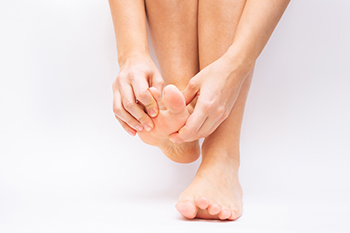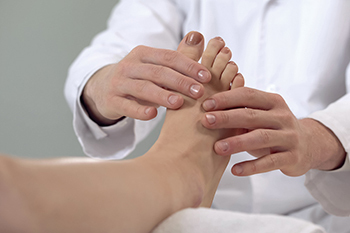Connect With Us
Blog
Items filtered by date: September 2022
How Do Ankle Sprains Occur?

It is common to twist an ankle. It can happen from a fall, or from unexpectedly stepping off of a curb. A sprained ankle can happen for the same reasons, and it is easy to notice as the ankle becomes painful and swollen. This type of injury happens when the ligaments stretch beyond their normal range of motion, and patients may gradually develop joint pain if prompt medical attention is not received. Additional symptoms that may accompany an ankle sprain can consist of bruising and tenderness when touched. An X-ray is often performed to rule out an existing fracture, and this precedes starting the proper treatment. It begins with resting and elevating the affected foot as often as possible, and wrapping it with an elastic bandage, which may provide stability. Additionally, there are exercises that can be performed which may restore and increase the range of motion. If you have sprained your ankle, please consult with a podiatrist as quickly as possible who can determine what the best form of treatment is for you.
Although ankle sprains are common, they aren’t always minor injuries. If you need your ankle injury looked at, contact Dr. Howard Horowitz from Bowie Foot & Ankle . Our doctor can provide the care you need to keep you pain-free and on your feet.
How Does an Ankle Sprain Occur?
Ankle sprains are the result of a tear in the ligaments within the ankle. These injuries may happen when you make a rapid shifting movement while your foot is planted. A less common way to sprain your ankle is when your ankle rolls inward while your foot turns outward.
What Are the Symptoms?
- Pain at the sight of the tear
- Bruising/Swelling
- Ankle area is tender to touch
- In severe cases, may hear/feel something tear
- Skin discoloration
Preventing a Sprain
- Wearing appropriate shoes for the occasion
- Stretching before exercises and sports
- Knowing your limits
Treatment of a Sprain
In many cases, the RICE method (Rest, Ice, Compression, and Elevate) is used to treat ankle sprains. However, you should see a podiatrist to see which treatment option would work best with your injury. In severe cases, surgery may be required.
It is important to ask your doctor about rehab options after you receive treatment for your injury. Stretching, strength training, and balance exercises may help the ankle heal while also preventing further injury.
If you have any questions, please feel free to contact our office located in Bowie, MD . We offer the newest diagnostic and treatment technologies for all your foot care needs.
Why Toe Pain Occurs

The function of the big toe is to provide and maintain balance while daily activities are completed. The big toe is also essential for participating in running and jumping activities. Many people can get pain in their big toe and this can happen for a variety of reasons. Arthritis is a condition that can cause pain in this toe, affecting the joints. In severe cases, arthritis can be crippling and may cause difficulties in walking. People who enjoy running may be prone to gradually developing arthritis in the toe and this may be accompanied by swelling and stiffness. Gout can also cause debilitating pain in the joints of the big toe. It can occur for genetic reasons or from eating foods that have high levels of purines, causing an elevation in uric levels. This can cause crystals to form in the joints of the big toe and it is often difficult to walk. Extensor tendonitis can develop from having tight calf muscles and arthritis that affects the joints. If you have toe pain for any reason, it is strongly advised that you seek the counsel of a podiatrist who can determine what the cause is and treat it accordingly.
Toe pain can disrupt your daily activities. If you have any concerns, contact Dr. Howard Horowitz of Bowie Foot & Ankle . Our doctor can provide the care you need to keep you pain-free and on your feet.
What Causes Toe Pain?
Most severe toe pain is caused due to a sports injury, trauma from dropping something heavy on the toe, or bumping into something rigid. Other problems can develop over time for various reasons.
Toe pain can be caused by one or more ailments. The most common include:
- Trauma
- Sports injury
- Wearing shoes that are too tight
- Arthritis
- Gout
- Corns and calluses
- Hammertoe
- Bunions
- Blisters
- Ingrown toenails
- Sprains
- Fractures (broken bones)
- Dislocations
When to See a Podiatrist
- Severe pain
- Persistent pain that lasts more than a week
- Signs of infection
- Continued swelling
- Pain that prevents walking
Diagnosis
In many cases the cause of toe pain is obvious, but in others, a podiatrist may want to use more advanced methods to determine the problem. These can range from simple visual inspections and sensation tests to X-rays and MRI scans. Prior medical history, family medical history, and any recent physical traumatic events will all be taken into consideration for a proper diagnosis.
Treatment
Treatments for toe pain and injuries vary and may include shoe inserts, padding, taping, medicines, injections, and in some cases, surgery. If you believe that you have broken a toe, please see a podiatrist as soon as possible.
If you have any questions please feel free to contact our office located in Bowie, MD . We offer the newest diagnostic tools and technology to treat your foot and ankle needs.
People Who Have a Fear of Falling May Lose Interest in Exercising

The simple mishap of slipping on the floor or tripping on a rug can cause many injuries, including unwanted foot conditions. A fall may result in a broken foot or sprained ankle, and this may complicate daily living. Falling is a common occurrence among elderly people, and it may instill a fear of completing everyday activities. This fear of falling may lead to refraining from participating in an exercise program, which may cause the muscles to lose strength. There are several things that can cause falling to occur, in addition to simple methods that can be implemented which can help to prevent them. These can include scheduling regular physical and eye examinations that can update existing medications and eyeglasses, and removing frayed rugs from the living environments. Additionally, many seniors choose to have grab bars installed in the shower and toilet areas, and it can help to use a bathmat. If you would like more information about the importance of using effective fall prevention techniques, please schedule an appointment with a podiatrist who can answer any questions you may have.
Preventing falls among the elderly is very important. If you are older and have fallen or fear that you are prone to falling, consult with Dr. Howard Horowitz from Bowie Foot & Ankle . Our doctor will assess your condition and provide you with quality advice and care.
Every 11 seconds, an elderly American is being treated in an emergency room for a fall related injury. Falls are the leading cause of head and hip injuries for those 65 and older. Due to decreases in strength, balance, senses, and lack of awareness, elderly persons are very susceptible to falling. Thankfully, there are a number of things older persons can do to prevent falls.
How to Prevent Falls
Some effective methods that older persons can do to prevent falls include:
- Enrolling in strength and balance exercise program to increase balance and strength
- Periodically having your sight and hearing checked
- Discuss any medications you have with a doctor to see if it increases the risk of falling
- Clearing the house of falling hazards and installing devices like grab bars and railings
- Utilizing a walker or cane
- Wearing shoes that provide good support and cushioning
- Talking to family members about falling and increasing awareness
Falling can be a traumatic and embarrassing experience for elderly persons; this can make them less willing to leave the house, and less willing to talk to someone about their fears of falling. Doing such things, however, will increase the likelihood of tripping or losing one’s balance. Knowing the causes of falling and how to prevent them is the best way to mitigate the risk of serious injury.
If you have any questions, please feel free to contact our office located in Bowie, MD . We offer the newest diagnostic and treatment technologies for all your foot care needs.
When to See a Podiatrist

A podiatrist is a doctor that treats the foot, ankle, and any connecting leg parts. They are known as a doctor of podiatric medicine or DPM, and these initials will appear after their name. Podiatrists must complete four years of study and training at a podiatric medical school. After this, they must complete residency training for three more years in a hospital or clinic. When they pass all required exams, they are certified by the American Board of Podiatric Medicine (APMA). Some of these doctors choose to specialize (such as in surgery, sports medicine, or pediatrics), and if they do this, they must obtain more training in their area of specialty. Podiatrists must be licensed in the state that they work in, and like other physicians, they must renew their licenses and keep up to date with their training. Like a family doctor or general care physician, unless they specialize, podiatrists treat people of all ages and for a range of conditions. If your feet hurt or if you have sustained an injury to your feet or ankles, it is time to see a podiatrist who can diagnose the problem and provide appropriate treatment. It is a good idea to have your feet checked by this type of doctor periodically anyway. Remember, your feet support your weight and get you through a lifetime of mobility.
If you are experiencing pain in the feet or ankles, don’t join the stubborn majority refusing treatment. Feel free to contact Dr. Howard Horowitz from Bowie Foot & Ankle . Our doctor can provide the care you need to keep you pain-free and on your feet.
What Is a Podiatrist?
Someone would seek the care of a podiatrist if they have suffered a foot injury or have common foot ailments such as heal spurs, bunions, arch problems, deformities, ingrown toenails, corns, foot and ankle problems, etc.
Podiatric Treatment
A podiatrist will treat the problematic areas of the feet, ankle or lower leg by prescribing the following:
- Physical therapy
- Drugs
- Orthotic inserts or soles
- Surgery on lower extremity fractures
A common podiatric procedure a podiatrist will use is a scanner or force plate which will allow the podiatrist to know the designs of orthotics. Patients are then told to follow a series of tasks to complete the treatment. The computer will scan the foot a see which areas show weight distribution and pressure points. The podiatrist will read the analysis and then determine which treatment plans are available.
If you have any questions please feel free to contact our office located in Bowie, MD . We offer the newest diagnostic and treatment technologies for all your foot and ankle needs.

